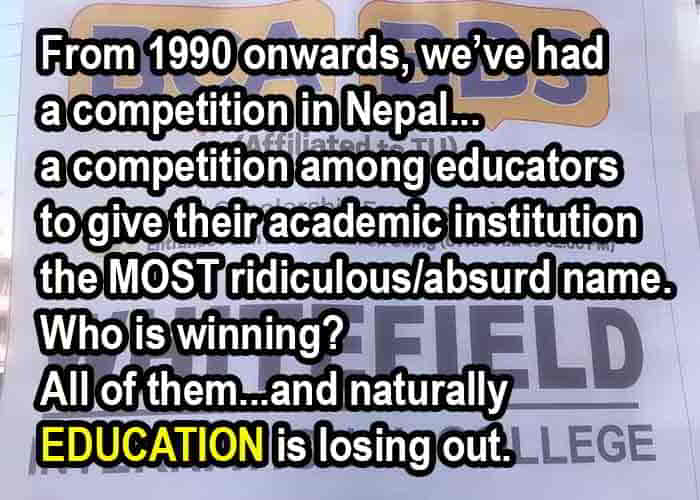
The race among many educators to give their academic institution the most ridiculous name started in the 1990’s. I know because I noticed it then and prepared a write-up about it when I was in Nepal in 1997-98. I came across the write-up again some days ago and published it as a blog post. (I even used parts of it in one of the episodes of the hour-long Kantipur FM music program I used to host in the Spring of 1998.)
I concluded the write-up thus, and I quote,
“What’s sad and pathetic is that a discerning person can immediately pinpoint, on the basis of all these changes, the direction the Nepali education system is heading in — namely, not a direction that merits serious consideration.”
More than two decades on, that’s exactly what appears to have happened! Those in the business of education continued with the farce: the competition to give their institution the most absurd name.
Let me start with one that got its name around the time the competition began–in 1995 to be precise (see tweet below)–and the names were still kind of “innocent” and “naive” if a little bit awkward.
There’s a race, a competition, among educators in #Nepal to give their private educational institute the most RIDICULOUS name.
— Dorje Gurung, ScD (h.c.) (@Dorje_sDooing) October 23, 2021
There’s no clear winner as yet though. Most are winning!
Here’s one of the many winners I have come across in Kathmandu!
😉😉😉😉😉
🤣🤣🤣🤣🤣 pic.twitter.com/6YY6c1qOUT
Here’s another one that’s also kind of cute, no different from many that sprung up in the 1990’s.
Here’s another winner!
— Dorje Gurung, ScD (h.c.) (@Dorje_sDooing) April 23, 2022
Where do they get these names?
Where?!?! #Nepal pic.twitter.com/wXSRZIvAoF
Moving on to their twenty-first century “modern” incarnations, I give you Whitfield International College!
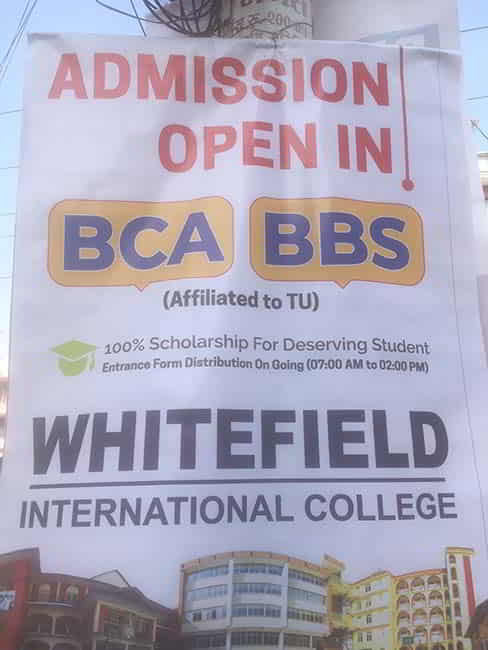
This is a college in Kathmandu Valley but no, you are right, there is NO Whitefield in the Valley. As far as I know, there has never been a famous or rich (philanthropic) Nepali individual or family by that name either. There could be a famous or wealthy international Whitefield individual or family who the college is named after, or one who funds–or donated the seed money for–it. Ullens School in Kathmandu, for instance, is named after the family whose foundation funded the school.
As for it calling itself an “international” college…for an academic institution to be international, at the very least it must have two of the following three:
- offer an international curriculum such as International Baccalaureate, Waldorf, John Dewey, Edexcel, Cambridge Assessment International Education, the International Primary Curriculum, Montessori etc., and not Tribhuwan University (TU) or some other local curriculum,
- have international teachers/administrators, and
- have an international student body.
Given that it says it is affiliated with TU in Kathmandu, what are the chances that it fulfills all three or at least two of the three criteria? Likely zero!
And Whitefield International is not alone in carrying such an incongruous name. As a matter of fact, were you doing research on education in the country and started by looking at the names of institutions in Kathmandu, you could be forgiven for concluding that the education here must be EXCELLENT! Why? Because you would have discovered an insane number of international schools and colleges! (Education in international schools are generally very good; I know because I worked as an international Chemistry/Science teacher around the world for almost twenty years.)
Furthermore, you could also be forgiven for thinking or believing that Kathmandu must have one of the highest — if THE highest — concentration of international schools in a capital city! Except, nothing could be further from the truth. A vast majority of them, of course, are not international, no different from Whitefield International College.
In reality, apart from Lincoln School, The British School, and The French School, I don’t know of other genuine international schools–ones that fulfills the criteria. I wouldn’t be surprised if there are a few dozen or so private schools that are similar to Ullens–named after some international donor or funder and/or offer international curriculum and/or even have a few international staff.
Regardless, here is a sample of academic institutions that, like Whitefield, sound like institutions located in some other part of the world instead of in Nepal AND/or sound like they are international institutions, and/or something quite unique–in the case of Greenfield National(!) College.
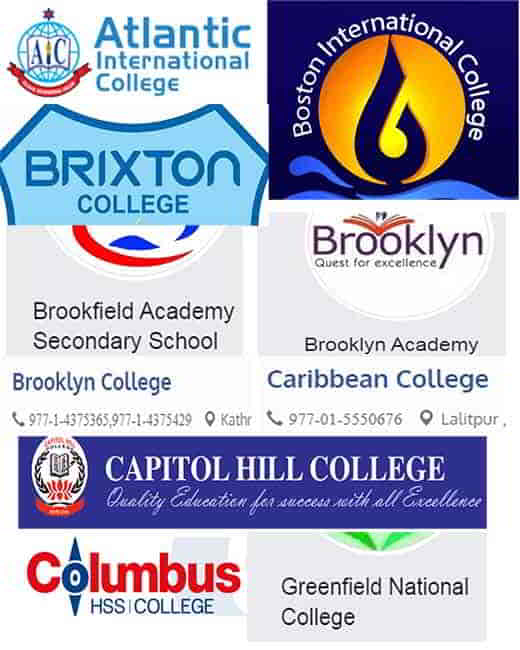
And if that wasn’t enough, here are some more, names starting from the alphabets G to N! We have Henry Ford, Loyola, Himalayan Whitehouse (!), Islington and Moscow etc. in Nepal! Who knew?!
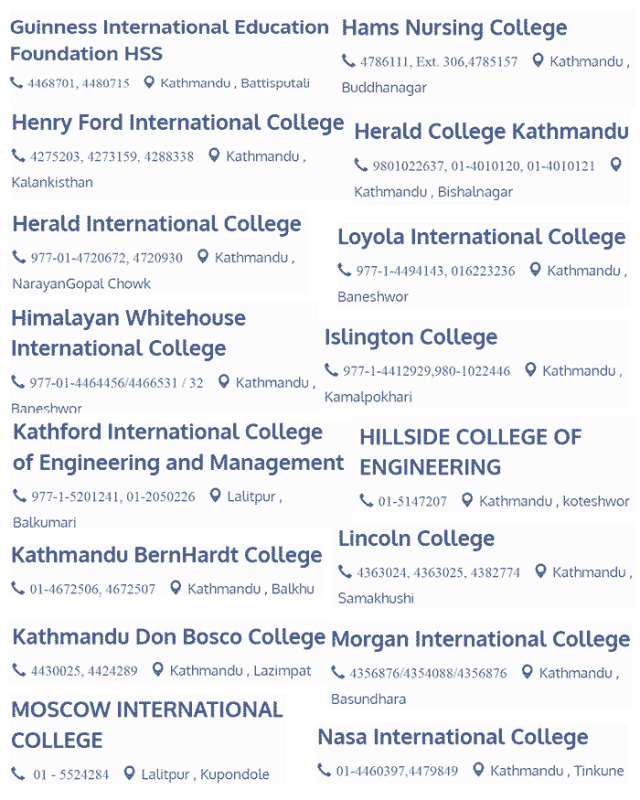
And here are the ones starting with O and P. We have Oxford in Butwal in the South!
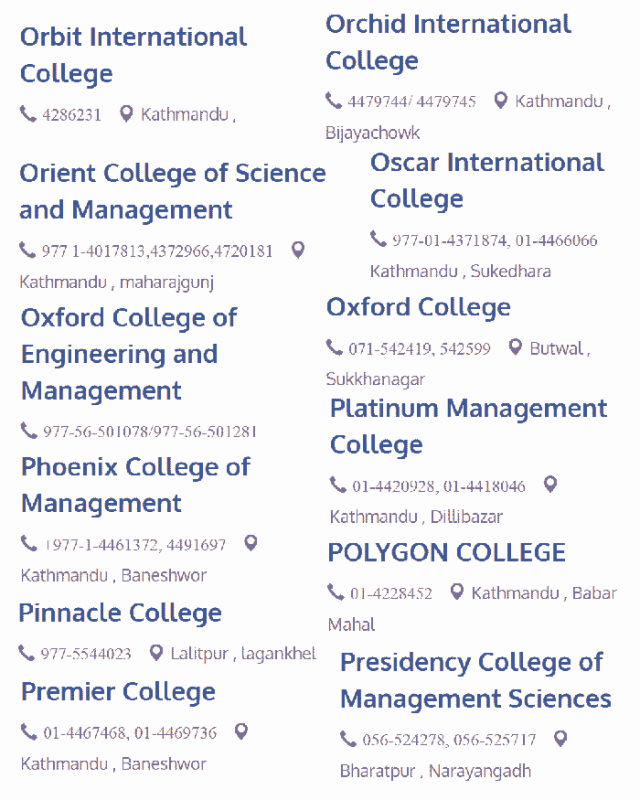
Find P to S below.
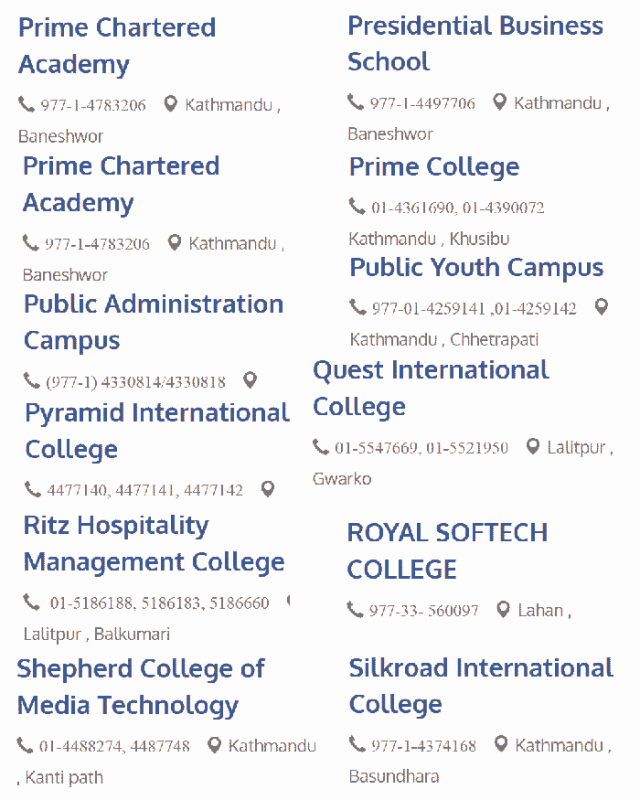
It’s now the turn of names beginning with S, T and U. We have Texas, Thames, and even Topper(!) Engineering and Management College!!
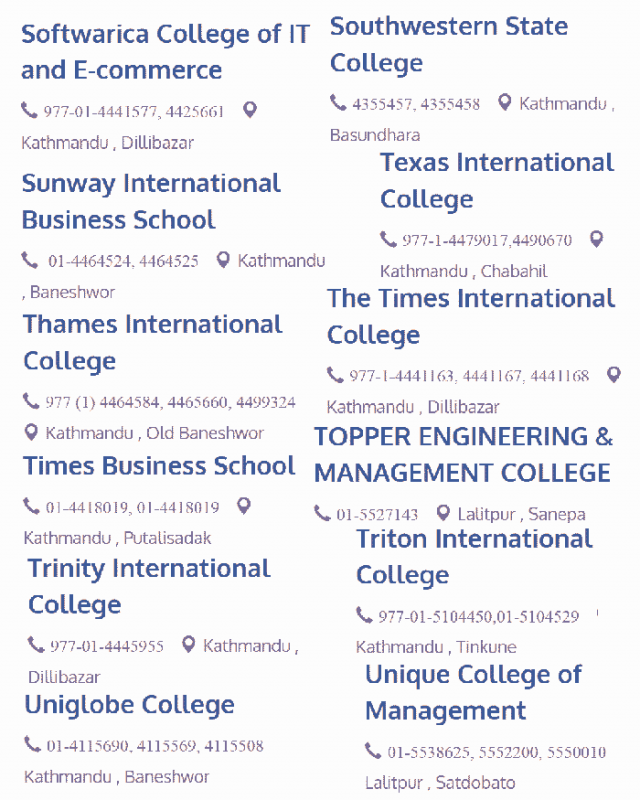
And finally, those starting with U to Z.
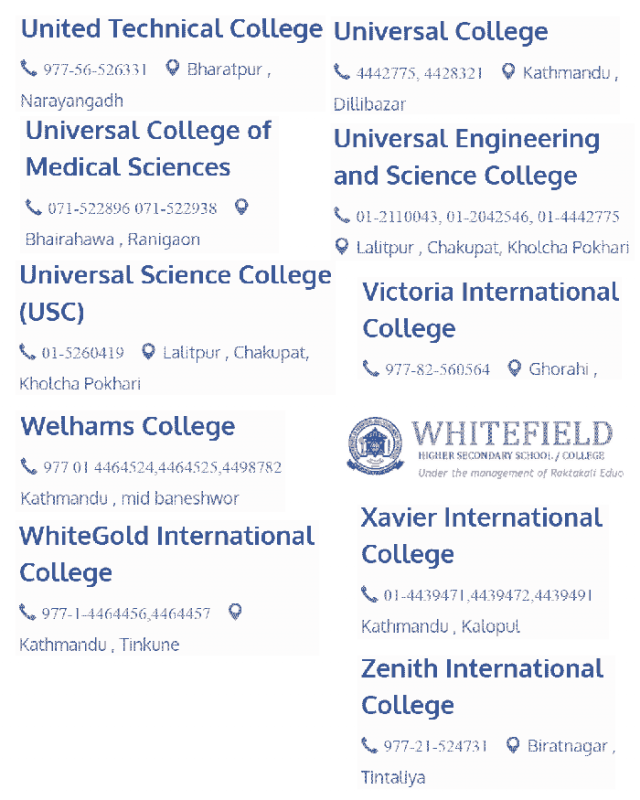
What do you notice?
You have to wonder what the priorities of “educators” involved in financing and/or funding and/or running private institutions such as these are. I do anyway! To be honest, I sense some perversion going on here.
In their defense, maybe because the country is unable to send abroad a majority of students for quality education, the educators decided that they would instead bring home at least the names of institutions–and those of places–abroad to the students.
Anyway, as you can see, international is a much abused term. Abusing words is a general problem in Nepal–using words to NOT mean what they denote. Yeah, very confusing. See the use of the word public in the example below for example.
In #Nepanglish, words don’t actually denote what they mean.
— Dorje Gurung, ScD (h.c.) (@Dorje_sDooing) August 22, 2021
Take for example the word “public” in the name of this school.
The school, for example, is NOT a public school but rather a private school!
So why does it call it a “public” school? Who knows! #Nepal pic.twitter.com/gyPfgnetap
Ghandaki School NOT a public school in the sense of the word “public” but rather a private one…unless you want to argue that they are using the term as they do in the UK!
So now, to conclude, we have moved on to National, International, and Public from Residental, English Medium and Academy of the 1990s.
If you are wondering who the winner of this competition is, as both the judge and jury, I’d say there’s no clear winner as yet; I would say they are ALL winners. 😀 The flip side of that is that education is losing, and so are our children. 🙁
One of the “best,” if I may, is Xavier International Montessori School.
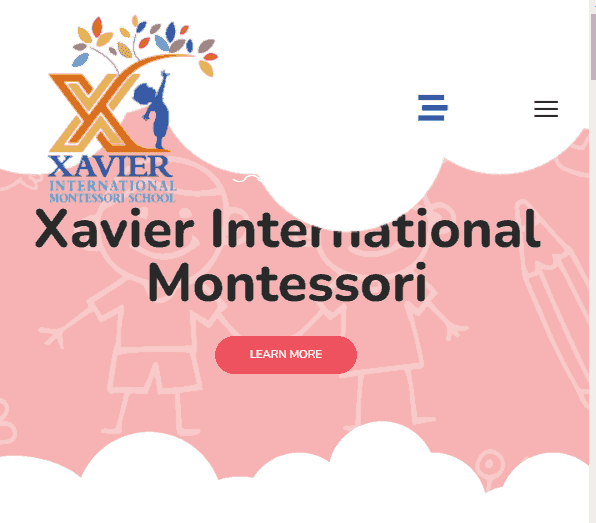
When I first heard about it, I had this to say in a Facebook post back in 2015.
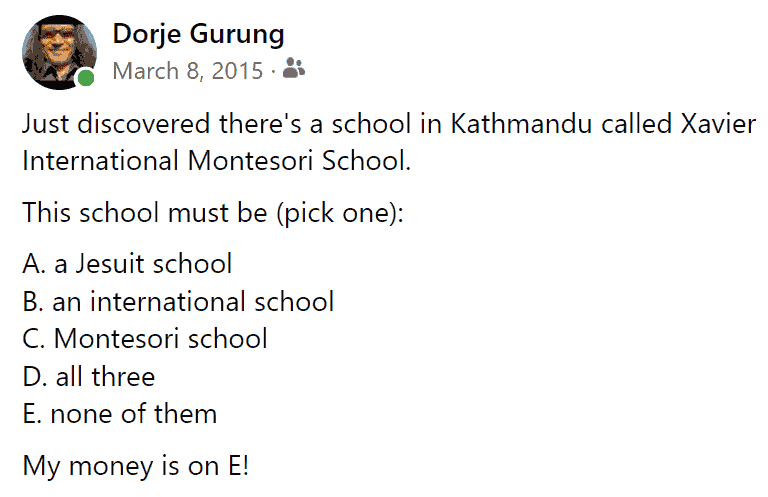
And another one that needs honorary mention is this school.
Here’s a question for you.
— Dorje Gurung, ScD (h.c.) (@Dorje_sDooing) December 13, 2022
When is “Advanced English” NOT a class?
When it’s in #Kathmandu. #Nepal 😁😁😁😁😁🤣🤣🤣🤣🤣🤣🤣🤣 pic.twitter.com/uHJX5uyOBq
But, after about three decades of this competition, Scholars’ Home Academy (!!!) has upped the ante, as it were. The competition is now about the motto (slogan?). 😉
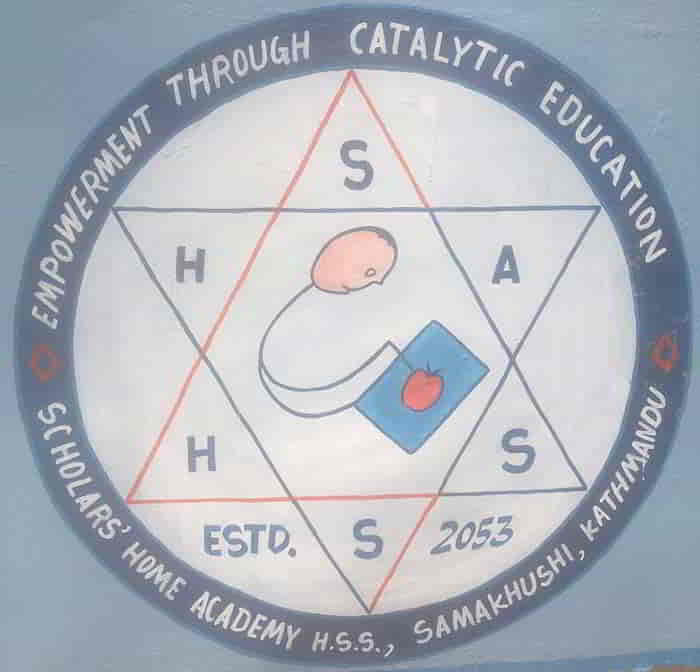
“Empowerment through catalytic education” reads the motto! Now, we just need others to join the competition.
What will school names and their mottos be like in another three decades? I doubt anyone will be able to predict given the level of creativity of Nepali educators when it comes to naming their schools and coming up with catchy mottos. 😀
But, seriously now, in Instagram posts such as this one made during the Coronavirus pandemic, drawing attention to this practice, I had proclaimed, and I quote,
“When we come out at the other end of this #pandemic, we in Nepal will have to have a SERIOUS analysis and evaluation of our system and make DRAMATIC changes if we are to prepare our future generations for anything like what we are contending with now.”
Will Nepal ever do that? I have serious doubts!
What’s education in a vast majority of these academic institutions like from how they were in the 1990s? Pretty much the same I imagine.
The focus in most cases, as far as I have been able to gather, is still getting students to memorize and regurgitate facts, figures, and answers to set questions. I’ll even go as far to state that a lot of what most of the educators, educational institutions, and the government of Nepal are doing in the name of education, to me frankly, is just embarrassing and many even shameful.
What do you think?
